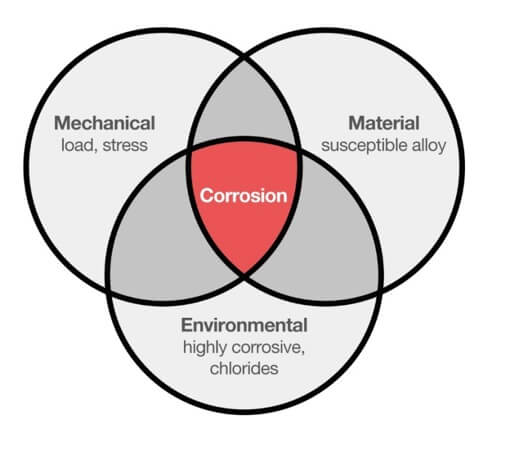This article comes from Moxa.
Metal surfaces of industrial equipment and structures are constantly at risk of corrosion, leading to equipment malfunction and irreversible structural damage. Demand for better equipment quality, more demanding operating environments, and longer warranty periods is forcing equipment manufacturers to take a closer look at their products. In this article, we discuss some techniques that equipment manufacturers and equipment owners can adopt to protect their equipment from corrosion and thereby increase the lifetime of their equipment.
Understanding corrosion and its effects on metals and alloys
Corrosion is a natural process wherein metals are transformed back to their stable original form when they come in contact with air and water. For example, when steel is exposed to moister and oxygen it starts regressing to its original state, i.e., rust or iron ore. Due to this being a natural process for metals, the prevention of corrosion is an uphill battle. However, current innovations in the field of corrosion prevention and control have made it possible to increase the lifetime of industrial equipment.
Material selection

Although it is hard to find materials that are 100% resistant to the effects of corrosive elements, careful selection of materials, especially when combining them in a product, can reduce corrosion.
Selecting the right material is a key factor to preventing corrosion in equipment. Although it is hard to find materials that are 100% resistant to the effects of corrosive elements, careful selection of materials, especially when combining them in a product, can reduce corrosion. A good understanding of the corrosion process in metals as well as knowledge of their mechanical properties and the metal strength required to withstand the effects of corrosion go a long way towards building corrosion-resistant equipment. The ISO 9223 standard for corrosion of metals and alloys and corrosivity of atmospheres defines corrosion categories based on the atmospheric wetness and pollution as well as the corrosion rate of metals in the atmosphere, which is a good guide when select material to build your equipment.
Product design
Design elements that are not given proper consideration may prove to be the weak link in corrosion control. When designing products, mechanical engineers should work closely with corrosion engineers to avoid crevices and overloaded structures that could cause pitting corrosion. Other design techniques include:
Using similar materials throughout a piece of equipment to avoid galvanic corrosion
Minimizing surface temperature differences in equipment exposed to extremely high/low temperatures
Avoiding concentration of stress on certain parts of the equipment
Manufacturing process
The manufacturing process can introduce implicit corrosion points in products. For example, the design may cause stress to be concentrated on certain parts, especially the joins, which are susceptible to corrosion when they are exposed to corrosive elements. These equipment parts require additional isolation protection. Metals tend to absorb hydrogen during the smelting and electroplating process, which then penetrates the plating layer rendering it ineffective. A dehydrogenation step needs to be introduced in the manufacturing process to eliminate the effects of hydrogen absorption by metals. A paint coating that is water-osmotic in nature can cause blistering on the surface of equipment, which can then lead to water seepage and eventually corrode the metal surface below the protective coating. Avoiding manufacturing practices that may cause corrosion and using the latest technologies and processes that can help arrest the corrosion of equipment are key considerations when planning.
External protection mechanisms
A cheaper way to protect metals against corrosion is to apply protective coating. The anticorrosion effect of a protective coating can vary based on its material composition. Zinc and aluminum are two metals that are used in protective layers because of their ability to block external corrosive factors. Anticorrosion technology also includes methods for active protection and passive protection. Active protection relies on the use of an external mechanism to reduce or resist corrosion, while passive protection relies on protection derived from the anticorrosion capability of the material used in the products.
How Moxa ensures protection of equipment operating in harsh environments
Moxa’s industrial panel computers and displays are also designed in strict accordance with globally accepted standards for explosion protection in hazardous locations. Approved certifications include UL/cUL Class I Division 2, ATEX Zone 2, IECEx Zone 2, and marine standards such as DNV GL, ABS, LR, NK, and CCS. Moxa’s tests it products for reliable operation in these harsh environments, including tests such as a continuous salt-fog test based on the EN 50155/NMEA 4X/ASTM B117/IEC 60068-2-11 standards. Click here to download the complete white paper. For more information on Moxa’s industrial panel computers and displays, check out our website.
Filed Under: Uncategorized




